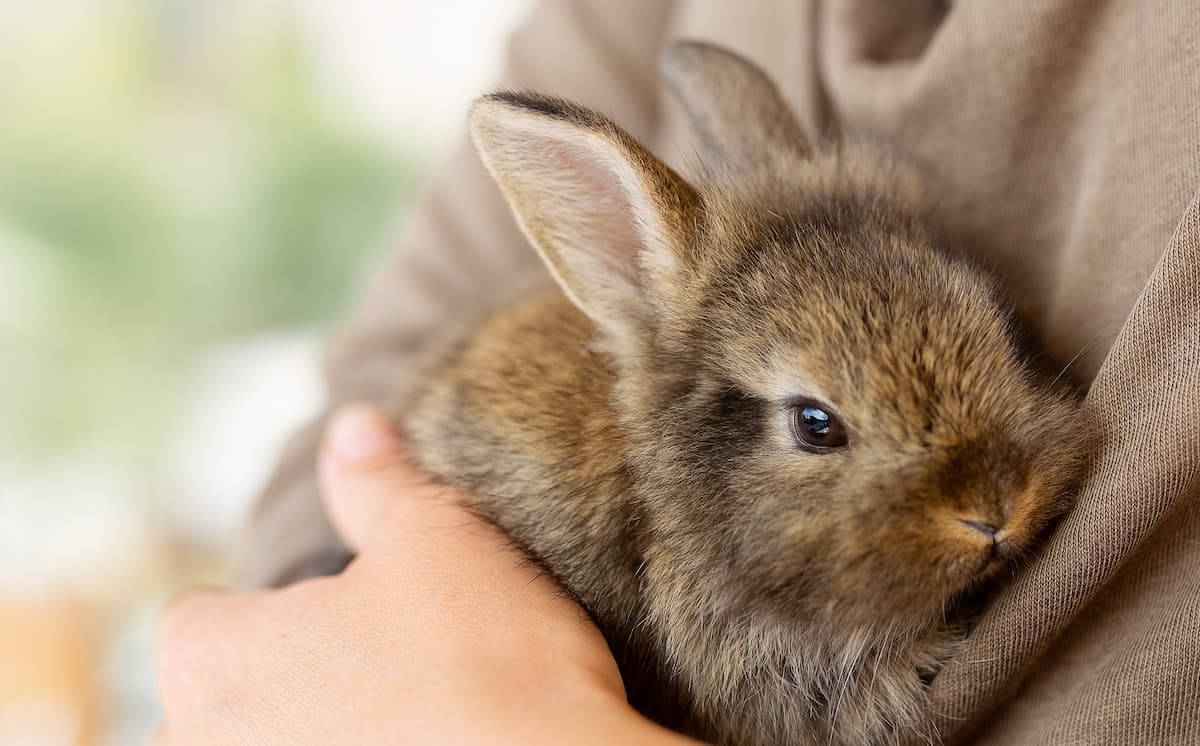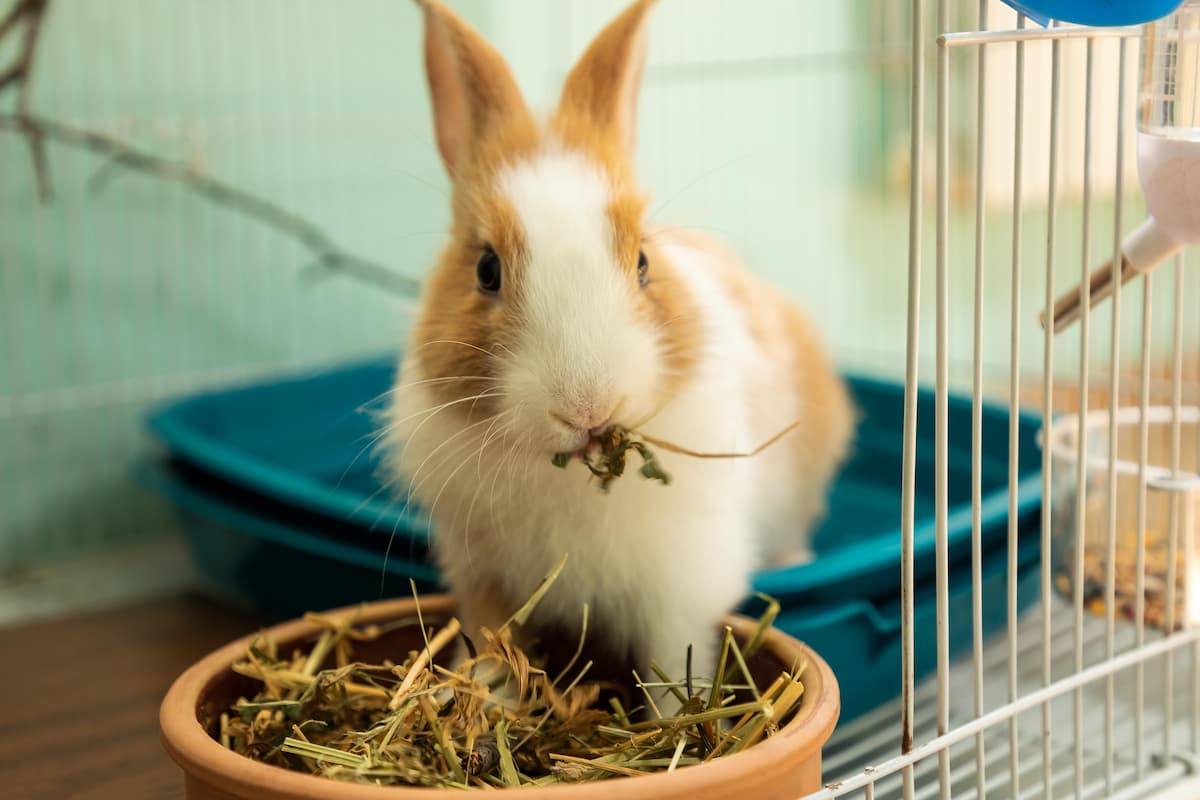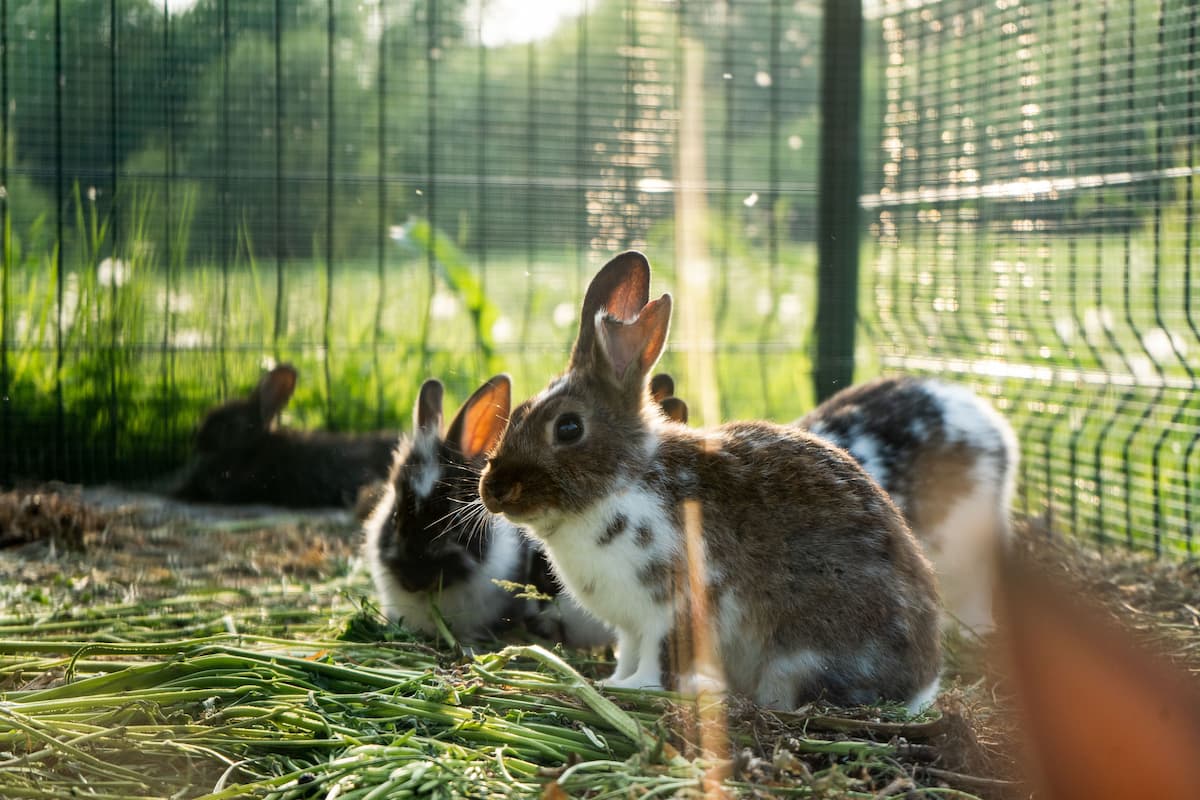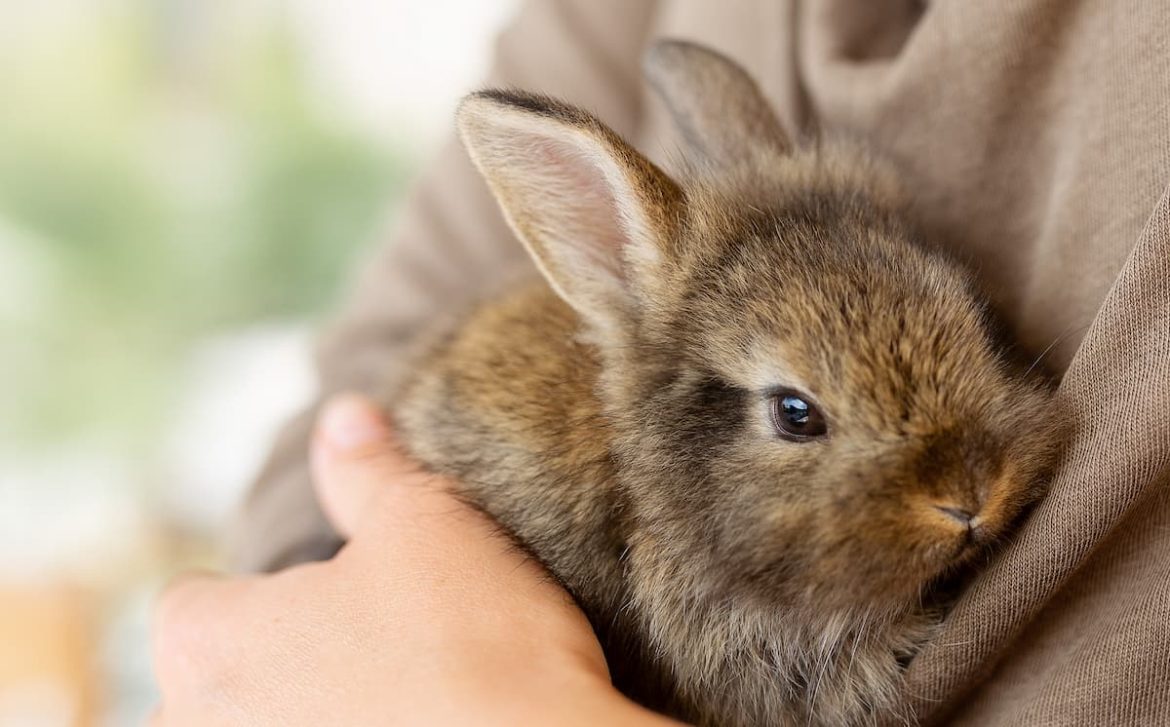With Easter approaching, you might think that now is the perfect time to adopt a pet rabbit into your family. It can be, as long as you’re prepared to provide adequate love and attention to these beautiful animals.
It’s a common misconception that rabbits are the perfect “starter pets” or ideal pets for children. But both of these assumptions are wrong. Rabbits are fragile and should not be handled by young children. In addition, they have a complex set of needs you must understand before making this commitment.
Let’s explore the question, “Are rabbits good pets?” so you can decide whether now is a good time to adopt or if it’s best to stick with chocolate bunnies this Easter!
 Housing for a pet rabbit
Housing for a pet rabbit
Research shows that over a fifth of all rabbits live in cages that are too small, and over half of pet rabbits aren’t allowed daily exercise. The problem is that while most owners are well-meaning, they don’t fully comprehend a rabbit’s accommodation and exercise needs. Many marketed rabbit hutches are simply too small to adequately house a bunny. So, how do you know which products are suitable for your pet rabbit?
As a general rule of thumb, rabbits require a hutch that is four times their body length and allows them to stand up without their ears touching the ceiling. Your bunny should be able to lie down in any direction, complete three hops along the length of their cage, and have a ceiling no lower than 45cm.
A hutch is not a home but a temporary enclosure to keep your pet rabbit safe. In addition, your bunny needs daily exercise, which allows them to engage in natural behaviours such as hopping, jumping, digging, and nesting. For this reason, it’s important to have a larger area—such as a bunny-proofed room in your house—where they can roam free for at least four hours a day.
Setting up their hutch or housing area
As rabbits are natural prey, they have a tendency to be fearful of many things, which is why they need a safe space to hide. Hutches with a covered area are ideal for satisfying this need, though there are some important considerations:
- The hutch must be kept out of direct sunlight if it is outdoors. Conversely, in the winter, it should be placed in a garage or brought indoors. The recommended temperature range for rabbits is 10-25 degrees celsius.
- Wooden hutches are the best option; metal isn’t suitable as it heats up too quickly, potentially exposing your rabbit to heat stress.
- Rabbit hutches must be cleaned daily to remove soiled bedding and food scraps. You can toilet train rabbits and even use a litter tray so that their waste remains in one area and is easier for you to clean. Use newspaper or towels to line the litter tray. Avoid cat litter, as this is not suitable for your pet rabbit.
Tip: Rabbits like to eat while they poop, so adding a little hay to their litter box will help to encourage them.
Feeding your pet rabbit
Rabbits are herbivores, meaning their diet consists entirely of plant-based foods. Around 80% of their diet should consist of hay, and they need constant access to this food source. Avoid cut grass, as it ferments quickly and can cause digestive issues for your rabbit.
Around 15% of a rabbit’s diet should consist of fresh vegetables like leafy green lettuce (NOT iceberg), bok choy, cilantro, dandelion leaves, kale, spinach, watercress, and broccoli (leaves and stems). Some vegetables can cause stomach upset, so when introducing a new food to your rabbit’s diet, do it gradually and monitor their reaction.
Now for the eye opener – contrary to popular belief, high-carb veggies like parsnips and carrots (yes, carrots!) should only be given as an occasional treat.
And, NEVER give your rabbit avocado, garlic, onion, or potatoes.
Only 5% of your rabbit’s diet should come from pellets or high-sugar foods like fruit. A diet that consists only of pellets will quickly lead to malnutrition. Additionally, avoid muesli because it can cause dental disease.
Did you know that rabbits’ teeth grow throughout their lives?
That’s why a high-fibre diet is essential, as it helps to wear down the continually growing teeth. Without this, rabbits’ teeth can become overgrown, making it painful for them to eat. If your rabbit has problems with its teeth, you’ll likely notice symptoms such as a reluctance to eat or drooling, which is a sign that your rabbit needs a visit to the vet.
Additionally, remember that rabbits need constant access to fresh, clean water. If you’re using a bottle, make sure the nib is placed 3-4 cm above the floor. This allows your bunny to access it easily but prevents the water from being contaminated with urine or faeces.
 Exercising your pet rabbit
Exercising your pet rabbit
Daily exercise is crucial for your rabbit’s health and wellbeing. If they live in a hutch, they need at least four hours of exercise per day in an area that allows them to run around and play. You’ll also need to provide enrichment tools so that they can engage in their natural behaviours. Here are some ideas:
Hiding
Rabbits are ground-dwelling prey creatures, so having places to hide allows them to feel safe. These could include:
- Cardboard boxes
- Tunnels
- Paper bags (with handles removed)
- PVC pipes
Digging
Rabbits love to dig, but you probably won’t want them digging holes all over your garden! A better alternative is to provide them with both digging and bunching materials to keep them happy:
- A sand pit or container filled with dirt, shredded paper, or child-friendly sand is a good option.
- You can also provide “bunching” materials such as towels or blankets that your bunny can pick up and rearrange around themselves.
- Provide toys and other objects your bunny can manipulate and explore, such as those in the pet store.
Foraging
In the wild, rabbits spend a lot of time foraging and nibbling on food. However, when you deliver food to them every day, they can become complacent or lazy. Adding foraging enrichment to their environment helps them to stay proactive in their search for food. Try the following:
- Hide food around their playpen for them to find
- Put treats inside empty egg containers
- Using pegs, hang vegetables around your bunny’s enclosure
- Hide healthy treats inside a foraging box (filled with shredded paper, hay, etc)
- Hide treats inside empty toilet rolls
Running and climbing
Rabbits love to run around, and some also like to climb. There are numerous ways you can allow them to engage in this behaviour safely:
- Provide them space to run around
- Securely set up a series of cardboard boxes for them to climb on
- Use cat towers or platforms for them to climb on and jump between
Tip: Ensure your rabbit has a place to hide at all times, even when you’re playing together.
Additionally, you need to ensure your rabbit is safe during playtime. Safety measures include the following:
- Make sure the room or area is “bunny-proofed”—secure (your rabbit can’t escape), free from other animals (such as cats or dogs), and hazard-free (e.g. remove or secure any loose cables).
- Don’t overcrowd the environment. Not only can it be overwhelming to your rabbit, but it will also restrict their space to run around and play.
- Introduce enrichment toys individually and see how your rabbit reacts to them. Like us, rabbits have their own personalities, so they’ll like some things but not others.
- Make sure you use appropriate toys and equipment. For example, if you’re using a cat tower as a climbing frame for your bunny, it must be small and low to the ground. Some cat towers can be 6 feet tall, and you wouldn’t want your bunny rabbit falling from that height!
- Check the environment. This is particularly important if you’re playing outside, as several plants are toxic to rabbits. You’ll need to ensure that your bunny doesn’t nibble them.
Rotate your bunny’s toys and equipment so they have fresh things to play with and don’t become bored.
Socialising your bunny
Rabbits are social animals, so it’s ideal to house them with at least one or more additional rabbit companions. These companions will keep your rabbit company while you’re away and help reduce stress. A desexed male and a desexed female often make a good pair. It’s important to keep note though, that it may take time and patience for them to get used to one another.
Contrary to belief, guinea pigs do not make good companions for rabbits. Rabbits often intimidate the smaller creatures and can pass diseases onto them. Both rabbits and guinea pigs prefer the company of their own species.
Remember that domestic rabbits are bred explicitly as pets and differ significantly from their wild counterparts. If you released your pet rabbit into the wild it couldn’t survive alone, which is why your rabbit will bond with you as you begin to look after them.
Your pet rabbit might not be able to talk to you in a language you understand, but they will love it when you talk to them and respond with squeaks and other noises to let you know how happy they are to be in your company.
 Pet rabbits and children
Pet rabbits and children
Don’t leave young children unsupervised with rabbits or allow young children to pick rabbits up. As previously mentioned, these are prey animals, so they really don’t like to be handled. Avoid picking them up where possible, but if necessary, place one hand under the rump to support their weight and gently place the other hand on their chest to secure them.
Never pick a rabbit up by one limb, and don’t pick them up by the scruff. Many mother animals pick up their babies by the scruff – but that’s during infancy. It’s incredibly uncomfortable for a fully grown rabbit (or cat or dog) to be picked up by the scruff and have all their weight hanging from a fragile piece of skin.
Rabbits are a long term care pet
So, let’s answer the question, ‘how long do pet rabbits live?’.
You may not realise how long pet rabbits can live—most will live for 10-12 years, so you need to ensure you can commit to this amount of time and care before adopting. They will require daily care, regular check-ups, vaccinations, and a long-term commitment from you to be their carer.
Of course, you won’t always be home, but if you are away, you’ll need to establish a carer for your bunny before you go. This carer needs to be an adult who knows what they are doing and will treat your rabbit with the love and attention that it deserves.
If you’re sick of asking family and friends to pet-sit or you’ve run out of options, Mad Paws offers a sitter service. We connect you to experienced sitters in your area, each vetted to ensure they’ll provide your pet with the best care.
Simply enter your postcode (or search by area) to view sitter profiles in your area. Once you narrow down the search, you can arrange a meet-and-greet to ensure they’re the perfect match for your pet.
Like any pet, rabbits require an investment of your love, time, and finances. Still, the love and companionship they will give you in return is the best reward!

